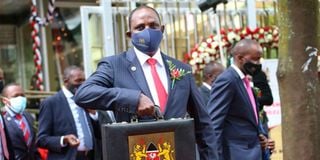Let’s prioritise growth of the economy in ’22

Treasury Cabinet Secretary Ukur Yatani displays the budget briefcase at The Treasury before leaving for Parliament Buildings for the reading of 2021/2022 annual budget on June 10, 2021.
What you need to know:
- The emergence of new Covid-19 variants could lead to reinstatement of restrictions, hampering economic growth.
- Elections generally pose the risk of destabilising an economy should there be political chaos and instability.
The economy recorded a 9.9 per cent growth in the third quarter of last year, up from the 2.1 per cent contraction recorded in a similar period in 2020, the Kenya National Bureau of Statistics (KNBS) Q3 2021 Gross Domestic Product Report shows, pointing towards continued economic recovery.
Consequently, the average GDP growth rate for the first three quarters was 6.9 per cent, an increase from the 0.8 per cent contraction over the same period in 2020. The average GDP growth rate of 5.9 per cent was a significant improvement from the 0.3 per cent contraction in 2020.
This year, the economy should continue its recovery trajectory with a projected GDP growth range of 4.3-4.7 per cent. The key supporting factors include continued recovery of businesses from the adverse effects of the pandemic, owing partly to the continued reopening of the external trading partners; growth in the real estate and construction sectors; and gradual increase in access to affordable credit — such that, as of last October, the private sector credit growth rate increased marginally to 7.8 per cent, from 7.7 per cent the previous month.
But key risks facing the economic growth that the government should be concerned include ongoing concerns on the sustainability of the public debt. It is expected that the government will have significant pressure to service it, with the debt-to-GDP ratio at 63.9 per cent, 13.9 per cent above the IMF-recommended threshold of 50 per cent for developing countries. A huge debt reduces the prospects of economic growth as a large portion of revenues is spent on servicing it rather than on development.
Economic recovery
Secondly, the emergence of new Covid-19 variants could lead to reinstatement of restrictions, hampering economic growth. For instance, the Omicron variant’s quick spread globally has led to logistical bottlenecks, exacerbating the supply chain disruptions, hence contributing to inflationary pressures.
The speed at which vaccines are received and distributed will also determine economic recovery.
Thirdly, elections generally pose the risk of destabilising an economy should there be political chaos and instability. The ripple effect is reduced production due to decreased business activity. This also leads to low investor confidence in the country and, consequently, negative capital net flows as witnessed in 2008 following the post-election violence.
Last is the expected subdued growth in the agricultural sector due to erratic weather conditions. Agriculture is the main economic driver, contributing 20.5 per cent of GDP as of Q3 ‘2021. Erratic weather conditions make it difficult for farmers to plan effectively, leading to under-supply of food products in the market, hence low production levels with both exports and domestic sales declining.
I, therefore, call upon the government to focus on these issues to help the country remain on the economic recovery path to the projected GDP growth.
Mr Wamayuyi is an economic researcher. [email protected]





